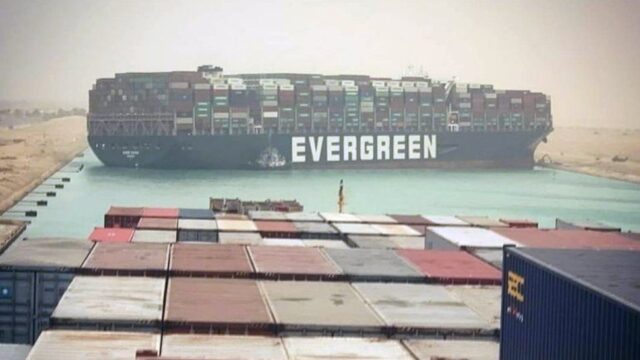On March 23, high winds blew the Ever Given off course as it passed through the Suez Canal, one of the world’s busiest shipping lanes. Sailing from Malaysia to the Netherlands, the giant container ship became wedged in sand in the southern section of the canal, blocking the narrow thoroughfare connecting the Mediterranean and the Red Sea for five days and leaving hundreds of ships in limbo.
At 400 metres long and 59 metres across at its widest point, the Ever Given is one of the world’s largest cargo ships. Classed as an ‘ultra-large container vessel’, the Ever Given can carry more than 20,000 containers. It dwarfed the tugboats, excavators and dredgers that worked around the clock until the ship was eventually refloated on March 29.
The recovery operation required specialist equipment, including a ‘suction dredger’ that can shift 2,000 cubic metres of material every hour. According to the BBC, if attempts to refloat the ship had failed, the next step would have been to unload the vessel of fuel and cargo in what would have been “a delicate and lengthy operation”.
What the world learned from the crisis
The incident highlighted a weak point in the global trade system, which sees 90 per cent of goods transported by sea. In 2019, more than 19,000 ships passed through the Suez Canal, equating to around 1.25 billion tonnes of cargo or 13 per cent of world trade.
Michael Bell, Professor of Ports and Maritime Logistics at the University of Sydney, says shortages of goods caused by the halt in shipping “will remind manufacturers of the fragility of global supply chains, and they may look at how to reduce their dependency on specific sources, particularly those that are distant and rely on container shipping”.
Bell believes disruptions such as the COVID-19 pandemic and the Suez Canal blockage will accelerate the shift towards smaller global supply chains and reduced freight kilometres due to factors such as increased mobile production, the miniaturisation of products such as flat-screen televisions, and the digitisation of materials such as books and manuals.
Maritime security expert Dirk Siebels says the Ever Given’s grounding highlights the critical issue of chokepoints in the global shipping industry. “These narrow channels – including man-made ones like the Suez Canal, but also natural ones like the Strait of Hormuz in the Persian Gulf and the Gulf of Oman or the Strait of Malacca between the Malay Peninsula and the Indonesian island of Sumatra – are part of the most important global sea routes. When merchant ships can no longer navigate through such a chokepoint, it may lead to supply delays and higher freight rates.”
The incident also calls into question the role of megaships in global shipping. High stacks of containers can catch wind like a sail, making the enormous ships difficult to control. The heavily laden ships are also at a higher risk of losing containers overboard in rough seas.
Infrastructure is also struggling to cope with these larger ships, says Evangelos Boulougouris from the University of Strathclyde. “Ports, straits and canals require expansion to make way for the new class of megaships,” he writes. “The cost of such projects is immense: the expansion of the Panama Canal in 2016 to accommodate bigger ships ended up costing over US$5 billion. In light of these infrastructural concerns, there may be an economic argument against expanding the number or size of megaships in our seas.”














